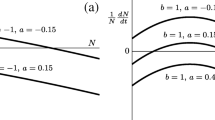Abstract
Bistability, the presence of alternative stable states, is an important feature of population models as it indicates that long-term predictions are dependent on the current population density. Two distinct kinds of bistability re-occur in population modelling studies, Allee Bistability and Positive Bistability. In this article, we show that a novel codimension-3 bifurcation, the cusp-transcritical interaction, can act as an organising centre for ordinary differential equations that exhibit both Allee Bistability and Positive Bistability. We first show how a normal form for cusp-transcritical interactions emerges from the unfolding of a particular one-dimensional degeneracy. We then illustrate the ecological relevance of the cusp-transcritical interaction. Finally, we provide a comprehensive example of normal-form analysis of an existing population model that demonstrates the occurrence of the codimension-3 bifurcation. We note that Allee Bistability and Positive Bistability may manifest unexpectedly in complex, ecological models, and therefore, this bifurcation-focused approach can provide valuable insight into the behaviour of newly developed ecosystem models.





Similar content being viewed by others
References
Turchin, P.: Complex Population Dynamics: A Theoretical/empirical Synthesis, vol. 35. Princeton University Press, Princeton (2003)
Ehrlich, P.R., Birch, L.C.: The “balance of nature” and “population control”. Am. Nat. 101(918), 97–107 (1967)
Scheffer, M., Carpenter, S., Foley, J.A., Folke, C., Walker, B.: Catastrophic shifts in ecosystems. Nature 413(6856), 591 (2001)
Beisner, B.E., Haydon, D.T., Cuddington, K.: Alternative stable states in ecology. Front. Ecol. Environ. 1(7), 376–382 (2003)
Stephens, P.A., Sutherland, W.J., Freckleton, R.P.: What is the allee effect? Oikos 87, 185–190 (1999)
Stephens, P.A., Sutherland, W.J.: Consequences of the allee effect for behaviour, ecology and conservation. Trends Ecol. Evolut. 14(10), 401–405 (1999)
Courchamp, F., Berec, L., Gascoigne, J.: Allee Effects in Ecology and Conservation. Oxford University Press, Oxford (2008)
Messier, F., Crête, M.: Moose-wolf dynamics and the natural regulation of moose populations. Oecologia 65(4), 503–512 (1985)
Ballard, W.B., Lutz, D., Keegan, T.W., Carpenter, L.H., deVos Jr, J.C.: Deer-predator relationships: a review of recent North American studies with emphasis on mule and black-tailed deer. Wildl. Soc. Bull. 29(1), 99–115 (2001)
Kot, M.: Elements of Mathematical Ecology. Cambridge University Press, Cambridge (2001)
Ludwig, D., Jones, D.D., Holling, C.S.: Qualitative analysis of insect outbreak systems: the spruce budworm and forest. J. Anim. Ecol. 42, 315–332 (1978)
Saputra, K.V.I., Van Veen, L., Quispel, G.R.W.: The saddle-node-transcritical bifurcation in a population model with constant rate harvesting. Discrete Continuous Dyn. Syst. Ser. B 14, 233–250 (2010)
Saputra, K.V.I.: Dynamical systems with a codimension-one invariant manifold: the unfoldings and its bifurcations. Int. J. Bifurc. Chaos 25(06), 1550,091 (2015)
Donohue, J.G., Piiroinen, P.T.: A technique for analysis of density dependence in population models. Theor. Ecol. 11(4), 465–477 (2018)
Thom, R.: Structural stability and morphogenesis: An outline of a general theory of models, trans. dh fowler. Reading, Massachusetts (1975)
Arnol’d, V.I.: Catastrophe Theory. Springer, Berlin (2003)
Harlim, J., Langford, W.F.: The cusp-hopf bifurcation. Int. J. Bifurc. Chaos 17(08), 2547–2570 (2007)
Bella, G., Mattana, P.: Bistability of equilibria and the 2-tori dynamics in an endogenous growth model undergoing the cusp-hopf singularity. Nonlinear Anal. Real World Appl. 39, 185–201 (2018)
van Veen, L., Hoti, M.: Saddle-node–transcritical interactions in a stressed predator-prey-nutrient system. arXiv preprint (2018) arXiv:1809.00108
van Kooten, T., de Roos, A.M., Persson, L.: Bistability and an allee effect as emergent consequences of stage-specific predation. J. Theor. Biol. 237(1), 67–74 (2005)
Thompson, J.M.T., Stewart, H., Ueda, Y.: Safe, explosive, and dangerous bifurcations in dissipative dynamical systems. Phys. Rev. E 49(2), 1019 (1994)
Golubitsky, M.: An introduction to catastrophe theory and its applications. SIAM Rev. 20(2), 352–387 (1978)
Sibly, R.M., Barker, D., Denham, M.C., Hone, J., Pagel, M.: On the regulation of populations of mammals, birds, fish, and insects. Science 309(5734), 607–610 (2005)
Courchamp, F., Clutton-Brock, T., Grenfell, B.: Inverse density dependence and the allee effect. Trends Ecol. Evolut. 14(10), 405–410 (1999)
Gascoigne, J.C., Lipcius, R.N.: Allee effects driven by predation. J. Appl. Ecol. 41, 801–810 (2004)
Huss, M., Nilsson, K.A.: Experimental evidence for emergent facilitation: promoting the existence of an invertebrate predator by killing its prey. J. Anim. Ecol. 80(3), 615–621 (2011)
de Roos, A.M., Schellekens, T., Van Kooten, T., Persson, L.: Stage-specific predator species help each other to persist while competing for a single prey. Proc. Natl. Acad. Sci. 105(37), 13,930–13,935 (2008)
de Roos, A.M., Persson, L., Thieme, H.R.: Emergent allee effects in top predators feeding on structured prey populations. Proc. R. Soc. Lond. B Biol. Sci. 270(1515), 611–618 (2003)
Dodds, P.S., Watts, D.J.: A generalized model of social and biological contagion. J. Theor. Biol. 232(4), 587–604 (2005)
Bradley, D.J., May, R.M.: Consequences of helminth aggregation for the dynamics of schistosomiasis. Trans. R. Soc. Trop. Med. Hyg. 72(3), 262–273 (1978)
May, R.M.: Thresholds and breakpoints in ecosystems with a multiplicity of stable states. Nature 269(5628), 471 (1977)
Evans, M.R., Grimm, V., Johst, K., Knuuttila, T., De Langhe, R., Lessells, C.M., Merz, M., O’Malley, M.A., Orzack, S.H., Weisberg, M., et al.: Do simple models lead to generality in ecology? Trends Ecol. Evolut. 28(10), 578–583 (2013)
Acknowledgements
This publication has emanated from research conducted with the financial support of Science Foundation Ireland under the grant number SFI/13/IA/1923.
Author information
Authors and Affiliations
Corresponding author
Ethics declarations
Conflict of interest
The authors declare that they have no conflict of interest.
Additional information
Publisher's Note
Springer Nature remains neutral with regard to jurisdictional claims in published maps and institutional affiliations.
Electronic supplementary material
Below is the link to the electronic supplementary material.
Rights and permissions
About this article
Cite this article
Donohue, J.G., Piiroinen, P.T. Normal-form analysis of the cusp-transcritical interaction: applications in population dynamics. Nonlinear Dyn 100, 1741–1753 (2020). https://doi.org/10.1007/s11071-020-05556-z
Received:
Accepted:
Published:
Issue Date:
DOI: https://doi.org/10.1007/s11071-020-05556-z




